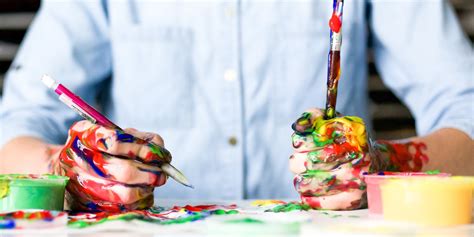Discover the benefits of self-expression through exploring different art mediums, gaining confidence, and creating a supportive art community. Embrace challenges and breakthroughs in developing your personal creative style.
Importance of self-expression in art
Self-expression in art is a crucial aspect of creativity and individuality. Through artistic creation, individuals are able to convey their thoughts, emotions, and experiences in a visual form. This form of expression allows for a deeper understanding of oneself and can serve as a therapeutic outlet for emotional release.
Furthermore, self-expression in art fosters a sense of authenticity and uniqueness. It encourages individuals to embrace their own perspectives and ideas, rather than conforming to societal norms or expectations. This freedom of expression not only benefits the individual artist, but also contributes to the broader cultural and artistic landscape.
Overall, the importance of self-expression in art lies in its ability to empower individuals to share their innermost thoughts and feelings, while also contributing to a diverse and enriched artistic community.
Exploring different art mediums
Art is a diverse and multifaceted form of expression that comes in many different shapes and sizes. One of the most exciting aspects of art is the ability to explore and experiment with different mediums. Whether it’s painting, drawing, sculpture, or mixed media, each medium offers a unique set of challenges and opportunities for self-expression.
When you take the time to explore the various art mediums available to you, you open yourself up to a whole new world of creative possibilities. Each medium has its own set of techniques, tools, and materials, and mastering them can be a rewarding and fulfilling experience. Whether you prefer the vibrant colors of acrylic paint, the delicate strokes of watercolor, or the tactile nature of clay, there is something for everyone to discover and enjoy.
By exploring different art mediums, you can also gain a deeper understanding of your own artistic style and preferences. You may find that you have a natural talent for a particular medium, or you may discover a new passion that you never knew existed. The more you experiment with different mediums, the more you will grow and develop as an artist, and the more confident and versatile you will become in expressing yourself creatively.
Benefits of hands-on art experiences
Hands-on art experiences offer numerous benefits for individuals looking to explore their creative capabilities. Engaging in tactile art activities allows participants to connect with their artistic instincts and unleash their inner creativity. The act of physically creating art can be a therapeutic and fulfilling process, providing a sense of accomplishment and satisfaction.
Furthermore, hands-on art experiences promote the development of fine motor skills and hand-eye coordination. Whether it’s sculpting, painting, or drawing, working with art materials requires precision and dexterity, which can improve these skills over time. This can be especially beneficial for individuals looking to enhance their coordination and manual dexterity.
Another advantage of hands-on art experiences is the opportunity for self-expression and personal exploration. Art allows individuals to communicate their thoughts, emotions, and experiences in a tangible and visual way, providing a sense of catharsis and emotional release. Through hands-on art activities, participants can develop a deeper understanding of themselves and their inner world, fostering a sense of introspection and self-awareness.
Developing personal creative style
Developing a personal creative style in art is a journey that every artist goes through. It involves honing in on your unique voice and vision, and expressing it through your work. It requires experimentation, self-reflection, and a willingness to push boundaries.
One way to develop your personal creative style is by exploring different art mediums. By experimenting with various materials and techniques, you can discover which ones resonate with you the most, and use them to bring your ideas to life.
Building confidence in your artistic abilities is also crucial in developing your personal creative style. This may involve overcoming self-doubt, embracing mistakes, and learning to trust your instincts. As you gain confidence, you’ll be more willing to take risks and explore new creative territories.
Building confidence in artistic abilities
Building confidence in artistic abilities is a crucial part of an artist’s journey. Many artists face self-doubt and insecurity about their work, which can hold them back from fulfilling their creative potential. However, by taking small steps and pushing themselves out of their comfort zones, artists can gradually build their confidence and develop a strong belief in their artistic abilities.
One way to build confidence in artistic abilities is by setting achievable goals and working towards them. By completing smaller projects and seeing progress, artists can boost their confidence and feel more capable in their skills. Additionally, seeking feedback from mentors or peers can provide valuable insight and reassurance, helping artists to understand their strengths and areas for improvement.
Another important aspect of building confidence in artistic abilities is practicing self-compassion. It’s natural to make mistakes or produce work that falls short of expectations, but it’s important to recognize these moments as opportunities for growth instead of letting them diminish confidence. By embracing a positive mindset and learning from setbacks, artists can develop resilience and belief in their abilities.
Challenges and breakthroughs in art
Creating art can be a rewarding and fulfilling experience, but it also comes with its fair share of challenges. Many artists face obstacles such as creative blocks, self-doubt, and the fear of failure. These challenges can be daunting and may even lead to feelings of frustration and discouragement.
However, it’s important to remember that overcoming these challenges can lead to significant breakthroughs in artistic expression. When artists push through their doubts and fears, they often discover new ways of approaching their work and develop a deeper connection to their creative process.
By learning to embrace and navigate these challenges, artists can ultimately grow and evolve in their practice, leading to breakthroughs that propel their art to new heights.
Sharing and discussing creative works
Sharing and discussing creative works is an essential part of the artistic process. It allows artists to gain valuable feedback, insights, and perspectives from others, which can help them grow and improve their craft. Whether it’s through art exhibitions, critique sessions, or simply sharing work in progress with fellow artists, the act of sharing and discussing creative works can be incredibly beneficial.
By sharing their work, artists are able to connect with others and build a supportive art community. This not only provides a sense of belonging and camaraderie, but also opens up opportunities for collaboration and inspiration. Discussing creative works with peers can also lead to new ideas, techniques, and approaches that artists may not have considered on their own.
Furthermore, receiving feedback and constructive criticism on their work can help artists identify areas for improvement and growth. It can also help them gain a better understanding of how their work is perceived by others, allowing them to make adjustments or refinements to better communicate their artistic vision. Ultimately, sharing and discussing creative works can lead to personal and artistic growth, as well as the development of a richer and more diverse artistic practice.
Creating a supportive art community
Creating a supportive art community is essential for artists to thrive and grow in their creative endeavors. When artists come together in a safe and encouraging environment, they are able to share their experiences, learn from one another, and gain valuable feedback on their work.
This type of community fosters a sense of belonging and connection, which can be incredibly beneficial for artists who may otherwise feel isolated in their creative pursuits. By collaborating with fellow artists, individuals can find inspiration, motivation, and a sense of camaraderie that is essential for maintaining a passion for art.
Supportive art communities also provide opportunities for artists to showcase their work, receive constructive criticism, and celebrate each other’s successes. These interactions help artists to grow and develop their skills, while also promoting a sense of unity and mutual respect within the community.
Frequently Asked Questions
What is the purpose of an art workshop for adults?
The purpose of an art workshop for adults is to provide a creative outlet for self-expression and personal growth through various art mediums.
What are some common art mediums used in an adult art workshop?
Common art mediums used in adult art workshops include painting, drawing, collage, sculpture, and mixed media.
Do I need to have prior art experience to participate in an art workshop for adults?
No, prior art experience is not necessary. Art workshops for adults are designed for all skill levels, from beginners to experienced artists.
How can an art workshop benefit adults?
Art workshops can benefit adults by reducing stress, improving mental well-being, stimulating creativity, and providing a sense of accomplishment.
What can I expect to learn in an adult art workshop?
In an adult art workshop, you can expect to learn new art techniques, experiment with different mediums, and receive guidance and feedback from an experienced art instructor.
How can I find an art workshop for adults in my area?
You can find art workshops for adults by searching online for local art studios, community centers, or adult education programs that offer classes and workshops.
Is it important to bring my own art supplies to an art workshop for adults?
It depends on the workshop. Some may provide all necessary art supplies, while others may require participants to bring their own. It’s best to check with the workshop organizer beforehand.





